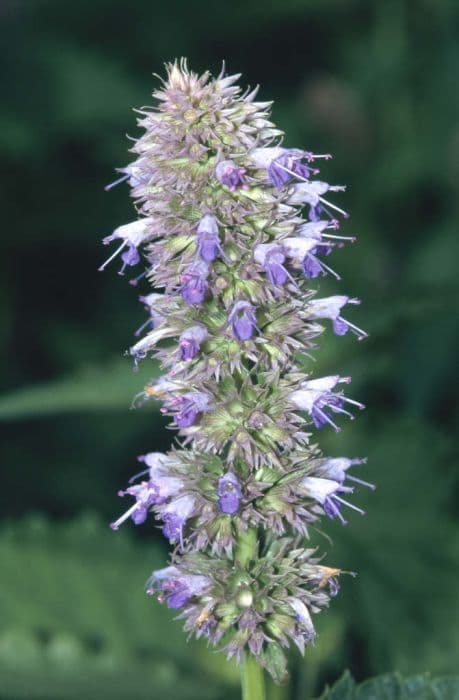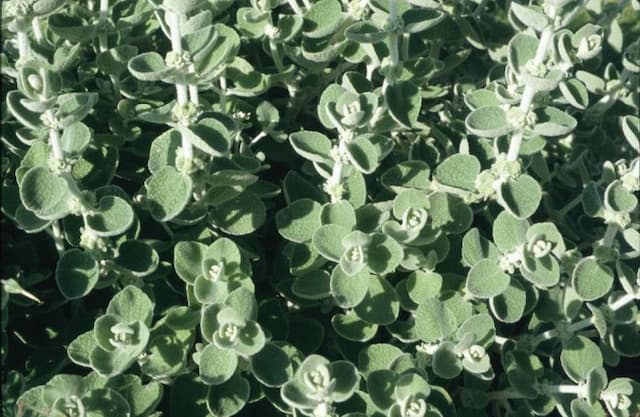Highdown Thyme Thymus 'Highdown'

ABOUT
Thymus 'Highdown', commonly known as Thyme, is a perennial herb with a bushy, mat-forming habit. Its foliage consists of small, aromatic leaves that are oval to narrow and typically a gray-green color. These tiny leaves are densely packed together on wiry stems, giving the plant a lush and full appearance that can be both soft to the touch and visually appealing in a garden setting. Throughout the growing season, Thyme produces small, tubular flowers. The blooms are usually a light lavender to pinkish-purple hue, adding a delicate splash of color to the plant. The flowers are attractive to bees and other pollinators, highlighting the plant's ecological importance. The blossoms are arranged in whorls at the top of the slender stems, creating a lovely contrast against the dense foliage beneath. The overall shape of Thyme can be described as cushion-like or mound-forming, spreading gently as it matures. Its appearance encapsulates a wild yet refined beauty, contributing to its popularity in ornamental gardens, culinary gardens, as well as in various landscape designs where it often serves as ground cover or edging plant. Fragrant when touched or crushed, the leaves of Thyme release a delightful scent that is both earthy and slightly floral, characteristic of the herb's essential oils. This fragrance, coupled with the plant's visual charm, makes it a multifunctional addition to any space that values sensory appeal.
About this plant
 Names
NamesFamily
Lamiaceae
Synonyms
Highdown Thyme, Lemon Thyme
Common names
Thymus 'Highdown'.
 Toxicity
ToxicityTo humans
Thymus 'Highdown' refers to a variety of thyme. Thyme is commonly used as a culinary herb and is not toxic to humans when consumed in typical food amounts. However, in very rare cases or when consumed in large quantities, it might cause gastrointestinal upset or allergic reactions in sensitive individuals. It is important to note that thyme essential oil, which is far more concentrated than the plant itself, should be used with caution, as it can be potentially toxic if ingested in significant amounts, leading to symptoms like dizziness, nausea, vomiting, or muscular weakness.
To pets
Thymus 'Highdown' or thyme is generally considered non-toxic to pets. It can be safely consumed by animals like dogs and cats when encountered in a garden setting or when given in small amounts as a part of their diet. There is no well-documented toxicity of thyme to pets, although, similar to humans, its essential oil or large amounts might potentially cause gastrointestinal upset or an allergic reaction in some pets. But overall, Thymus 'Highdown' does not pose a significant risk of poisoning to pets when encountered as a plant.
 Characteristics
CharacteristicsLife cycle
Perennials
Foliage type
Evergreen
Color of leaves
Green
Flower color
Pink
Height
1 foot (30 cm)
Spread
1 foot (30 cm)
Plant type
Herb
Hardiness zones
5
Native area
Mediterranean
Benefits
 General Benefits
General Benefits- Aromatic foliage: Thymus 'Highdown' has fragrant leaves that can be used to add a pleasant aroma to gardens and landscapes.
- Culinary uses: The leaves can be used fresh or dried to flavor a variety of dishes.
- Attracts pollinators: The flowers attract bees, butterflies, and other beneficial insects, which aid in the pollination of nearby plants.
- Drought tolerance: Once established, it is drought-resistant, making it suitable for xeriscaping and low-water gardens.
- Ground cover: Due to its low-growing habit, Thymus 'Highdown' can spread to form a dense mat, preventing weed growth and soil erosion.
- Low maintenance: It requires minimal pruning and care once established, making it ideal for gardeners looking for low-effort plants.
- Edging and borders: Thymus 'Highdown' is suitable for creating decorative borders or edgings along paths and flower beds.
- Hardy perennial: It is a hardy plant that can withstand cold temperatures and return each year.
 Medical Properties
Medical Properties- Antimicrobial activity: Thymus species are known to possess essential oils that have demonstrated antimicrobial effects against various bacteria, fungi, and viruses.
- Antioxidant properties: The plant may contain phenolic compounds that have antioxidant activity, helping to protect cells from oxidative stress.
- Antitussive: Thyme, which is a common name for Thymus species, has been traditionally used in herbal medicine to help relieve coughs and symptoms of acute bronchitis.
- Antispasmodic: Thyme has been used to relieve smooth muscle spasms, such as those in the gastrointestinal tract.
- Expectorant: The plant may help in loosening phlegm and relieving symptoms of respiratory conditions.
- Carminative: Thyme is considered to aid digestion and relieve gas and bloating.
 Air-purifying Qualities
Air-purifying QualitiesThis plant is not specifically known for air purifying qualities.
 Other Uses
Other Uses- Culinary Herb: Thymus 'Highdown', commonly known as thyme, can be used as a culinary herb to flavor a range of dishes, including soups, stews, and marinades.
- Garden Landscaping: Thyme is often planted in gardens for its fragrant foliage and attractive flowers, adding aesthetic value to rock gardens, borders, and pathways.
- Natural Pest Repellent: Thyme can be planted in vegetable gardens to help repel certain pests naturally, such as cabbage worms.
- Companion Planting: Thyme is beneficial when planted near brassicas (cabbage family) as it can deter pests that are attracted to these vegetables.
- Ground Cover: Due to its low-growing habit, thyme serves as an excellent ground cover to reduce soil erosion and suppress weed growth.
- Lawn Alternative: Some gardeners use thyme as a fragrant, low-maintenance alternative to grass in their lawns, particularly in sunny locations.
- Aromatherapy: The essential oil extracted from thyme leaves is used in aromatherapy for its soothing and calming effects on the mind.
- Dye Production: The leaves and flowers of thyme can be used to produce a natural dye for coloring textiles or crafts.
- Crafts and Decorations: Fresh or dried sprigs of thyme are often used in wreaths, floral arrangements, and other crafts for their pleasant scent and appearance.
- Potpourri Ingredient: Dried thyme retains its fragrance and can be included in potpourri mixtures to freshen up indoor spaces.
Interesting Facts
 Feng Shui
Feng ShuiThyme is not used in Feng Shui practice.
 Zodiac Sign Compitability
Zodiac Sign CompitabilityThyme is not used in astrology practice.
 Plant Symbolism
Plant Symbolism- Courage: Thymus, commonly known as thyme, has been a symbol of courage since ancient times. It was used in various cultures to embolden warriors and give them fortitude before battles.
- Strength: Thyme represents strength, both physical and of character. It symbolizes the vigor one needs to overcome challenges and obstacles.
- Healing: With its uses in medicinal practices, thyme carries connotations of healing and restorative properties, symbolizing the body's and mind's ability to heal and rejuvenate.
- Purification: Historically, thyme has been associated with purification, with its use in incense and fumigants aiming to cleanse and sanctify spaces.
- Passage: Thyme's perennial nature and resiliency through seasons can symbolize the passage of time and the ability to endure and adapt through life's changes.
 Water
WaterHighdown Thyme should be watered deeply but infrequently, allowing the soil to dry out between waterings to mimick its natural drought-tolerant conditions. Typically, during the growing season, watering once every 7 to 10 days is sufficient, but this can vary based on climate and soil conditions. When watering, aim to apply about one gallon per square yard every two weeks, adjusting as needed based on weather conditions, such as increasing water during hot, dry spells and decreasing during cool, wet periods. Avoid overhead watering to minimize leaf wetness and potential disease issues. It's crucial to have well-drained soil to prevent waterlogging which can cause root rot.
 Light
LightHighdown Thyme prefers full sun conditions, thriving best in a spot where it receives at least six to eight hours of direct sunlight daily. An area with bright, unfiltered sunshine encourages healthy growth and optimum flavor and aromatic oils in the leaves. If you live in a particularly hot climate, providing partial shade during the hottest part of the day can help prevent scorching the leaves.
 Temperature
TemperatureHighdown Thyme is tolerant of a wide range of temperatures, but ideally, it thrives in temperatures between 60°F and 80°F. The plant is hardy and can survive in temperatures as low as -20°F to -30°F, while high temperatures are typically well-tolerated as long as the plant is well-watered. It is important to avoid cold, wet soils, especially in winter which can be damaging to the plant.
 Pruning
PruningHighdown Thyme benefits from occasional pruning to promote bushy growth and to prevent legginess. Pruning should be done in the early spring or after the thyme has flowered in the summer. Trim back up to one-third of the growth to maintain shape and encourage new, fresh foliage. Regular trimming can also prevent the woody part from becoming too prevalent, keeping the plant attractive and productive.
 Cleaning
CleaningAs needed
 Soil
SoilThe best soil mix for Highdown Thyme is well-draining with a gravelly or sandy component. It prefers a pH range of 6.0 to 8.0, which is slightly acidic to alkaline. A mix of two-thirds coarse sand or perlite and one-third compost or potting soil works well.
 Repotting
RepottingHighdown Thyme does not require frequent repotting and can typically be repotted every 2-3 years or as needed when the plant outgrows its current container. Ensure to use well-draining soil mix when repotting.
 Humidity & Misting
Humidity & MistingHighdown Thyme thrives in low to moderate humidity conditions, making it suitable for typical household environments. It does not require high humidity and can tolerate dry air.
 Suitable locations
Suitable locationsIndoor
Provide full sun, well-draining soil, and infrequent watering.
Outdoor
Plant in full sun, well-draining soil, and space 12 inches apart.
Hardiness zone
5-9 USDA
 Life cycle
Life cycleThymus 'Highdown', commonly known as Highdown Thyme, begins its life as a seed, which, when sown in well-drained soil and exposed to sunlight and warmth, will germinate into a small seedling. The seedling grows into a young plant with characteristic tiny, aromatic leaves and a penchant for spreading low to the ground. As it matures, Highdown Thyme develops into a robust, woody-stemmed perennial, producing clusters of purple or pink flowers in the summer which attract pollinators such as bees. After the flowering stage, the plant sets seeds, which can be dispersed by wind or wildlife to propagate the next generation. In the fall, Highdown Thyme may die back slightly, although in milder climates it can retain its leaves and remain evergreen. Over the years, with proper care and ideal conditions, it can spread and form a dense, fragrant ground cover, completing its life cycle through perennial growth and annual flowering and seed-setting.
 Propogation
PropogationPropogation time
Spring-Early Summer
Thymus 'Highdown', commonly known as Highdown Thyme, can be propagated most popularly through stem cuttings. The best time to take cuttings is in late spring or early summer when the plant is actively growing. Select a healthy, non-flowering stem and cut a 2 to 4-inch segment (5 to 10 centimeters) just below a node. Strip the leaves from the lower half of the cutting, dip the cut end into rooting hormone powder to encourage root development, and plant it in a well-draining soil mix. Cover the cutting with a plastic bag or place it in a propagator to maintain high humidity, and keep it in indirect light until roots have formed, which usually takes about 2 to 4 weeks. Once the cuttings have rooted, they can be transplanted into individual pots or the garden.









